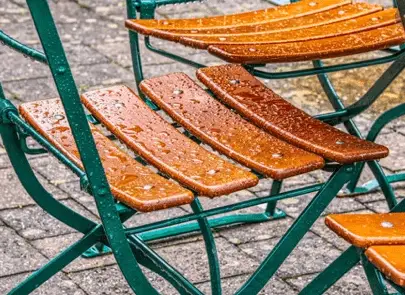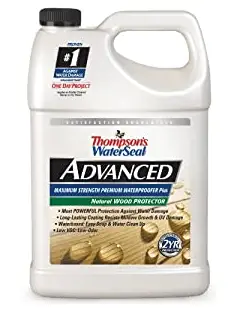Let’s face it; we all buy everything intending to use it for as long as we need it. It is no different with outdoor wood furniture. We all would want our beautiful outdoor bench and other furniture to last forever.

The painful truth is that the furniture will at some point wear out and we will be forced to replace it with a new one.
While we cannot live with our outdoor wood furniture forever, we can do something to ensure the furniture completes its shell life.
In addition to, covering your outdoor furniture, the way we can do this is to maintain the furniture by waterproofing it against the incessant rainwater that mainly contributes to its wear and tear through rotting.
But even before we concern ourselves with how to waterproof our outdoor wood furniture, understanding the need for and the risks of not waterproofing are necessary.
Why you should waterproof your outdoor wood furniture
If you have been torn between waterproofing your outdoor wood furniture and leaving it unsealed, I urge you to read the discussion below and thank me later. Outdoor wood furniture takes a lot of beating from the weather elements as well as insects and pests.
During the hot summers, wood furniture withstands the harmful UV rays from the sun and this may cause warping of the wood and will not last enough as it is expected. It also takes a toll on the heavy frost and ice during the cold winter months.
That is before leaves and heavy downpour falling on the outdoor furniture in the spring season. And that is not all; insects can also feed on outdoor wood furniture, while pests like squirrel and bird droppings land on the outdoor wood furniture. All these things contribute to the degradation of the wood, hence reducing its longevity.
The solution to this problem is waterproofing your outdoor wood furniture. It gives the wood a protective layer against UV rays, debris, mildew, and rainwater. It also discourages insects from feeding on the wood, Thereby prolonging its shelf life.
I know by now you are eager to know how to waterproof your outdoor furniture and get over with it. But before then, the type of wood you choose for your outdoor furniture also plays a critical role in determining the shelf life and that the waterproof does not come off so soon.
Which Woods are Best for Outdoor Furniture
Different types of wood wear and tear at different rates so be keen when choosing your outdoor wood furniture. With regular waterproofing and care, some woods warp faster than others while some will give you continued service for decades.
Most of these durable woods are quite expensive but the many years of service will be worth the investment. The best wood types for outdoor furniture are teak, red cider, cypress, and redwood.
Preparing the wood for waterproofing
A piece of unsealed outdoor wood furniture has taken lots of beating form elements and may as a result have stains, mildew, wood rot, and puddles of water on its surface. This is very common if you just came out of the winter season.
You cannot apply the waterproof over the dirty wood; doing so gives puddles on the surface even after the waterproofing. The Preparation of wood for waterproofing involves some activities that include drying the wood, sweeping, and sanding. If the furniture has been under a tree, take into an open field for drying.
Drying and water testing the wood
This takes between 2-3 days; depending on the type of wood and the amount of water it had taken in. On the 3rd day, conduct water to ensure the wood is ready for treatment.
Pour a cup of water across the wood and observe what happens. If the wood absorbs the water in the first 30 seconds, then it means the wood is dry enough and ready for waterproofing. If it takes more than 30 seconds to absorb the water, it means you will have to wait a little longer.
Scrubbing and sanding the wood
Once the wood is dry, use a hard brush to sweep across the wood surface. This works by removing the dry debris, mold, and mildew. However, scrubbing the wood will not get rid of all the stains on the wood and this is where the next step comes in; sanding.
Use thick sandpaper to scrub back and forth and in circular motions all over the furniture. And as you do that, do not forget all the crevices, corners, and underside. Your wood should now be looking fresh and clean as if it were new again.
Choosing the right waterproof

The same way you use sunscreen to protect your skin against the heat from the sun at the beach, your outdoor furniture wood needs some type of waterproofing.
There is a wide array of options to go with when choosing waterproof material for your outdoor furniture.
Your choice of waterproofing material will be determined by your unique style and what you look to achieve in your outdoor living space. You can either go with latex paint, varnish or sealers, stains, and repellants.
Latex paint
This is a great choice of waterproofing material for outdoor wood furniture since it offers complete protection against UV rays and water. And because it comes in many colors it allows you to showcase your unique style and tastes.
Latex paint is the waterproof material to go with if durability is at the top of the list of your concerns. The only drawback with latex paint is that it masks the wood grain, something that some people, me included, are not ready to give up.
Wood sealants
If you want a sealant that gets the job done but you are not ready to part with the aesthetic natural look of grains, then wood sealants are your choice. They include wood sealants and water repellants. On the flip side, they are not as durable as latex paint. But you can always schedule waterproofing every year.
Varnish
The varnish is a great choice for material for waterproofing outdoor wood furniture. It may not be as durable as latex paint but it will at least last you for a whole year of stylish and classic look and feel.
Be advised that although varnish allows wood grains to show, the details are a little dark. You might therefore want to consider a different wood waterproof material if your wood has small grain details since these would be buried by the varnish.
Apply the first coat

Whatever your choice of waterproof may be, the process should always begin with the application of the first coat. Wood oil makes the best primer since it makes the sealant stick easily and better.
Never be tempted to apply the primer directly to the wood; doing so risks the formation of puddles. Instead, pour some oil on a soft rag and use it to spread the oil all over, beginning to form the underside and finishing with the exterior.
Staring with the interiors ensures that both sides dry at the same rate since the underside is hidden from the direct sunlight. Avoid touching the wood while applying the primer and instead focus on achieving a uniform coating.
Allow the first coat to dry
Having achieved an even coat on the wood furniture, let the primer sit for 30 minutes before wiping the excess oil off the surface. The wait time allows the oil to settle deep into the wood so that puddles do not form later when applying the finish.
Then let the furniture air dry for about 24 hours or more, depending on the type of primer you chose for your wood. For oil wood primer, the wait time may even go up to 2 days since it is more viscous than the other sealants. Once dry, wipe the surface of the wood with a soft cloth to remove dust and ensure the finish sticks better.
Apply the other coats
With a clean first coat nicely done, it is now time for the second coat. Apply the second coat of your waterproof choice with a soft cloth and let it dry. Repeat the steps above before applying the finish.
A nicely done waterproofing requires 3 coats of your preferred choice of sealant. This is most recommended when dealing with varnish and wood sealants. But if you choose to go with latex paint as your waterproofing material for your outdoor wood furniture, then 2 coats will do the trick.
Protect the furniture from the elements
It does not how good your outdoor furniture wood is or how strong the sealant is; but if you do not prevent the furniture from the elements, all your efforts will soon go down the drain.
That being said, install a roof over your deck to protect the furniture from rain and direct sunlight. Also, use furniture glides to raise the furniture above the ground. This protects the furniture from resting on puddles during a heavy downpour. This way, you will have saved your outdoor furniture waterproof from speedy wear and tear.
Having done that, curl up in your outdoor wood furniture and enjoy the fruits of your hard work!